

This article will cover five sections addressing various aspects:
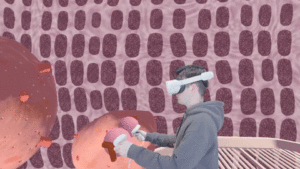
Virtual reality has long surpassed its association with just gaming. At XReady Lab, we specialize in creating VR content for biology, physics, and chemistry lessons specifically designed for classroom use. Our primary focus is on developing content that aligns with school curriculums, ensuring our apps are suitable for educational purposes rather than home use or supplementary education. We take into account the optimal length of our virtual labs, include testing features, and provide student performance metrics for teachers.
While we cannot guarantee the suitability of apps developed by others for classroom use, we regularly test external content and curate a list of recommended apps for schools. We encourage our customers to explore and utilize content from other developers, particularly in subjects where we do not specialize, such as history, geography, or language learning. We are always happy to recommend high-quality apps from other developers to enhance the learning experience.
![]()
At XReady Lab, we offer an annual renewable license for our simulations. The price varies based on the number of devices and the number of subjects you choose (available subjects: physics, biology, chemistry).
For more information, including a price quote for your school, a list of VR simulations, a free VR/Desktop demo, or any other inquiries, feel free to contact us ⬇️⬇️⬇️
We understand that school staff may worry about students playing games instead of learning. That’s why we developed VR Class software for the teacher’s computer, which enables teachers to:
Our VR Class software is also compatible with VR apps from other developers.
Let’s start by determining the required square footage for your VR classroom. This depends on the number of students per lesson. To ensure safety and prevent students from accidentally hitting each other, allocate 1.5 x 1.5 meters per student.
However, it’s not necessary for all students to wear VR headsets simultaneously. This approach can be costly in terms of purchasing the devices and challenging in terms of room selection. It is perfectly acceptable to have one device for every two students.
Let’s consider a concrete example: if your typical class size is 20 students, you’ll need 10 VR devices. This means 10 students will be using VR simultaneously, each requiring a 1.5 x 1.5 meter space to work comfortably. The recommended total floor area is 1.5 x 1.5 x 10 = 22.5 square meters (or slightly less). The shape of the room isn’t crucial; it can be a long corridor (approximately 15 x 1.5 meters), a more typical rectangular room (around 7.5 x 3 meters), or an almost square room (about 5 x 5 meters).
The ideal scenario is having a dedicated room specifically for a virtual reality classroom, like the one shown below.
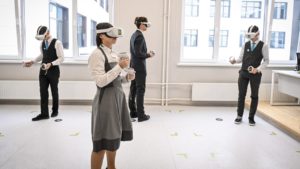
A classroom designed for virtual reality lessons, with stickers on the floor indicating the boundaries for each student.
If you don’t have a separate room, don’t worry. Many schools conduct virtual reality lessons in classrooms that are also used for regular lessons. In the photo below, you can see a typical physics classroom with tables and chairs pushed to the periphery.
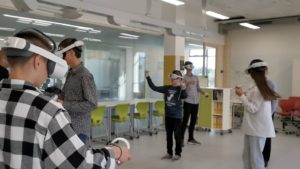
A regular physics classroom with tables and chairs temporarily pushed to the periphery, allowing students to comfortably engage in VR simulations.
The VR classroom should be equipped with adequate electrical outlets for charging VR devices, reliable Wi-Fi, and a designated area for the teacher and their computer to manage the entire class’s VR devices. Optionally, it should include storage space for VR devices, such as a shelf or cabinet.
It’s important to note that direct sunlight can interfere with VR devices. Therefore, especially in cities with bright sunny weather, consider installing blinds or similar shading solutions.
Avoid setting up a VR classroom in unsuitable locations, such as large hallways under glass domes, as this can significantly impact the effectiveness of the setup.
At XREADY LAB, our focus is on developing educational simulations tailored for school education and game development. While we do not manufacture VR devices ourselves, we extensively test various models to determine their suitability for educational environments.
In this introductory review, we will provide recommendations on VR devices that we believe are suitable for schools based on their price-to-features ratio.
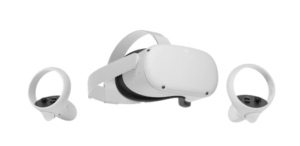
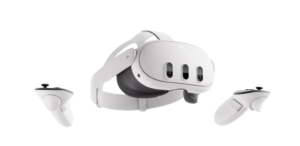
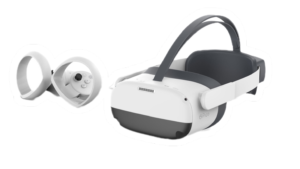
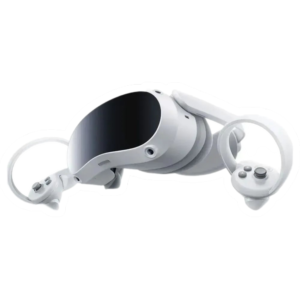
When selecting VR devices for educational settings, it’s crucial to consider several key factors to meet the needs of both students and educators. The following devices (Meta Quest 2, Meta Quest 3, Pico Neo 3, Pico 4) are well-suited for schools due to the following reasons:
Even if we’re discussing purchasing the devices at retail, the models we recommend typically range in price from $300 to $600 on average. Prices can vary based on factors like memory size and the country of purchase.
Apple Vision Pro: The first model of this much-anticipated device, released in February 2024, is primarily targeted at Apple enthusiasts. With a steep price tag of around $3,500 per device, it features imperfect controls and lacks a diverse range of educational content. While this may improve in the future, we currently do not recommend this device for schools, even those with substantial budgets.
Devices from VR Content Producers: Be cautious with VR devices that are designed to install only content from a specific developer. Even if these devices are slightly cheaper, you may eventually be dissatisfied with the quantity or quality of the content, its price, or other factors, and you won’t be able to download alternative content.
Network setup, hardware setup, license activation, and teacher training are all taken care of for you. These are the things you don’t need to worry about.
Feel free to contact us to try a free demo of our VR simulations. If you already have at least one VR device, you can try our VR app for free. If you don’t have VR devices yet, we will provide you with a desktop version.
For a free demo, VR classroom price calculation, or any other questions, please fill out the form on our website, and we’ll be in touch! ⬇️⬇️⬇️
You may like it
Frequently Asked
We prodive VR biology, VR physics, and VR chemistry simulations. Please, check our catalog.
Please, fill the form to get demo labs for free.
Please contact our customer support service at support@xreadylab.com or book a call with the team to find out the conditions and book the VR class set up at your school.
Subscription to XReady Lab interactive VR labs. If you are a school, then you are also given access to the VR classroom system. VR class system helps you easily launch VR lessons for a large number of students, follow the experience of each student, as well as customise the content without developers.
We adhere to the world’s generally accepted recommendations and research. Our products are suitable for children from 12 years old.